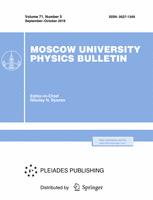The peculiarities of nuclear-resonance reflectometry (NRR) for different types of magnetic ordering in multilayers are considered. The theory of NRR for noncollinear magnetic structures is briefly presented. Model calculations are carried out for the [$^{57}$Fe(8Å)/Cr(20 Å)]$_{30}$ structure, in which the magnetization varies with depth in different ways. The results show that the <<magnetic>> maximum on the NRR curve occurs only when the directions of the hyperfine fields in adjacent iron layers have different projections on the synchronous beam direction. Spiral alignment of the multilayer magnetization causes the emergence of satellites near the Bragg maximum, while the <<magnetic>> maximum does not occur. With more complicated magnetic ordering profiles the characteristic features of available experimental curves can be explained.
75.70.-i Magnetic properties of thin films, surfaces, and interfaces
Department of Physics, Moscow State University, Moscow, 119991 Russia



